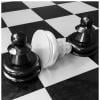Default Displacement Values in DS
 Masterstroke
Posts: 2,304
Masterstroke
Posts: 2,304
Hi there can anybody tell me the default displacement grey value in DAZ Studio? What is the basic background grey?
You currently have no notifications.
 Masterstroke
Posts: 2,304
Masterstroke
Posts: 2,304
Hi there can anybody tell me the default displacement grey value in DAZ Studio? What is the basic background grey?

Licensing Agreement | Terms of Service | Privacy Policy | EULA
© 2025 Daz Productions Inc. All Rights Reserved.
Comments
128,128,128
Thank you :-)
Strictly 127.5, 127.5, 127.5 - since it's the mid point between black, 0,0,0, and white, 255,255,255. But remember that there isn't a neutral value as such - the minimum and maximum values are set, the zero displacement (if there is one) is determined by those.
Yup, that's why I end up using min -1.007 with the max +1 for a midgray displacement map, for zero displacement.
Don't the triple figures mean the image map is RGB? I always thought Displacement was one of the parameters that works best if the map is actual greyscale, not RGB that just happens to be all grey.
As far as I know height maps as well as specular maps are all in RGB space. Don't think actual greyscale maps would make a difference.
Bump, Displacment and Opacity maps are greyscale
Well I checked a number of height maps just to be sure, and they are (desaturated) RGB images.
For bump, displacement and opacity iray does convert rgb images to grayscale anyway, even if they include color data. So they only take 8 bits per pixel in vram. Plus there's compression.
There has been annecdotal evidence that creating the map for bump, displacement, opacity as a grayscale file may produce better results in some cases because Iray isn't doing it's own "best effort" job at converting and compressing it.
Ok:) Maybe 3DL is more forgiving?
Diotto for having the greyscales in a lossless format, such as png (over jpg).
So what about the thousands of products in my runtime with RGB bump- and displacement maps? Converting to a grayscale png will magically make for a higher quality map?
No, because converting from a compressed format to an uncompressed one doesn’t undo the compression in the original file.
First, I believe that 3Delight is more forgiving.
The one case I recall where we were investigating it was with an extreme closeup where the compression of a transparency map made a difference in the result. So I wouldn't bother with a wholesale change of all your maps, only in cases where very subtle differences could make a difference.
Exactly! Which raises the question what these RGB jpg heightmaps are doing in my runtime. One would think that a PA, that wants to offer the best quality, would save the maps as greyscale png:s while at it.
Yes I can understand it would make a difference under certain circumstances
I'm understanding it as going the other way round — having a greyscale map in the first place means less of the degradation that happens with an on-the-fly conversion from RGB.
Wouldn't be the first time an "always been done that way" never got round to being corrected. Keep in mind that not all file and parameter specs were accurately and widely known in the beginning of DAZ|Studio; some of these glitches date back to the early Poser days.
Yeah you're probably right .
.
I personally believe that most PAs are not too much technically skilled, especially those developing textures. That's why addons such as the scene optimizer are needed. It is some time now that iray is out and I can't see any improvement in textures optimization and/or quality. Apart the expanded size that's per se killing iray.
Speaking of control maps...I'm a 3DL user, but curious as to why some IRay products have AO maps. Why would you use them with a PBR renderer?
Now, now Richard (wags finger) you know full well there is no 127.5 in the 0 to 255 color palette .
.
3DL at any rate uses 128's as neutral, but as Richard says that depends on the min/max settings, if they aren't "level" then you can push neutral away from 128's. By "level" I mean +/- the same value, ie MIN = -0.1 and MAX = 0.1 won't push neutral from 128, but a MIN of -0.1 and MAX of 0.2 will push neutral away from 128, which means 128's will now add a slight displacement to the mesh.
The two attached images show the results of using a black and white displacement map in 3DL, first one is the default disp at 100%, MIN -0.1, MAX 0.1, the negative displacement from the black is clearly visible at the join between the torso and limb surfaces. The second image has one change, I set MIN to 0, zero basically turns off MIN/MAX so you don't get any Disp from that setting, but you can look at it as having turned black to neutral if you want to .
.
Now at 100% Disp and a MIN/MAX of +/- 0.1 then black/white will displace about 1 mm in either direction, so I'll leave to you to figure out just how far +/- 1 will displace.
I have seem them used as controls, for instance in a "Top Coat Weight" channel to control how much top coat is applied in different areas. In an old texturing tutorial I read from Stefan "Stonemason" Morrell, he talked about using an AO map for deciding where the wear and tear on a surface should be or where the grime would accumulate.
But for pure Ambient Occlusion? No point at all.
Ok, kind of makes sense, tks;)